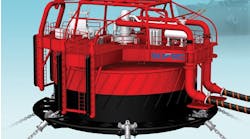Evaluation of drilling rig fluids handling systems
A comprehensive evaluation of the mud mixing, solids control, and waste management systems on drilling rigs prior to spudding a well has been shown to have a dramatic impact on operational efficiency and ultimate fluid-related costs. In one Gulf of Mexico well, modifications to the fluids system enabled the operator to save over $48,000 in fluid-related costs. In another well, adjustments to the solids control system eliminated synthetic mud losses costing the operator up to $2,000 an hour.
Auditing the fluids handling capabilities of rigs is a critical component of a unique integrated program aimed at optimizing the design, delivery and management of fluids and wastes at the wellsite. To avoid any unexpected problems during the drilling program, the inspection, which includes everything from examining the shakers, mud mixing system and the mud pits, should ideally be conducted early in the planning stages of an integrated fluids engineering (IFE) project. Audits have been conducted on newbuilds, rigs undergoing refurbishment, and even to improve the solids control and waste management efficiency of units while a well is in progress.
Enhance productivity
The integrated fluids program exploits the natural grouping of all fluid-related products and services. Owing to the improved drilling efficiency and the synchronized approach to solids control and waste management it encourages. The initiative is helping operators realize significant savings in drilling costs, while simultaneously increasing production and enhancing their environmental protection efforts.
The new approach is based on the belief that fluids and fluids-related equipment represent a natural grouping of products and services at the wellsite. This grouping is natural to the extent that the performance of individual components is interdependent, meaning significant opportunities exist to achieve better results by managing these processes jointly and using combined resources to execute them. The natural grouping includes drilling, drill-in and completion fluids; solids control and filtration equipment and waste treatment and remediation services.
The truly integrated service incorporates total fluid and waste management planning procedures, best practices, benchmarking, newly developed software and other fluid technologies, thereby differentiating it from simple service bundling approaches. The completely linked product and service approach includes an integrated data management system, featuring a common database to analyze the interactions between the fluid system components. This approach is viewed as fundamental for continuous analysis and improvement.
Rig checklist
The rig inspection, which is conducted with the aid of an all-inclusive Rig Evaluation Manual, includes three primary categories: solids control, fluids handling, and mixing systems.
When it is deemed necessary to examine the inner workings of such equipment as centrifuges, desanders, desilters, and mud cleaners, manufacturer representatives accompany the inspecting engineer. Additionally, the inspector conducts a safety audit of all areas where fluid engineers will be working, such as the pit room and shaker house.
When performing an analysis of the solids control system, the integrated fluids engineer looks first at the flowline to determine if there is sufficient diameter and drop to allow for the anticipated flowrate. The location of a gumbo box is noted and evaluated for usefulness, ease of access and mechanical operation. There a few vital questions to be addressed during the evaluation of the solids control and waste management capabilities of a rig:
- Age and condition of the shakers
- Direction of the motor rotation
- Belt tension
- Condition of the jacks, cushions and seals are examined in depth
- Desander, desilter, and mud cleaner operating with sufficient pressure at the manifold
- Inside of the cones showing
- Motor operating with sufficient horsepower and speed
- Degasser properly installed for peak efficiency
- Plumbing and pump sizing sufficient
- Will additional equipment be wasted or will it add to the removal efficiency of the total system?
System sufficiency
Correspondingly, the inspector examines the dump valves, with the primary aim of making certain the pits can be easily cleaned, thus avoiding unnecessary rig downtime. The maximum and minimum usable volume of mud in the pits is determined.
In examining the mud mixing system, the engineer determines if there is a sufficient number of hoppers for the amount of chemical and bulk material needed for the mud system to be run on the individual well. Can drum and "tote tank" materials be mixed easily and does the rig have a shearing hopper onboard? If not, is there space for one?
The ability to mix slug and still add premix or base fluid to the mud system is analyzed. Here, it is also important to note dry bulk material can be added while taking on or mixing dry bulk cement. These items are addressed in order to determine whether the mixing system will be able to keep up with anticipated rates of penetration on this project.
Pilot inspection
The first rig to be inspected under the new program was a newly refurbished inland barge in Louisiana, preparing to drill its first well after the renovation. The operator was to drill the well with a 17.5 lb/gal mud system incorporating hematite as the weighting agent.
Given the well was being drilled with a high-density mud system under zero discharge conditions, the inspection team suggested the rig be equipped with dual centrifuges. Further, rather than adding a mud cleaner, it was determined that the existing solids control equipment would be adequate when complemented with the installation of a linear motion shaker beneath the existing desanders and desilters.
Early in one inspection, it was noted that 20-in agitator blades were too small for the 15-ft-by-17-ft pits, thereby not generating agitation sufficient to keep the hematite weighting material suspended. If this situation were not corrected, hematite would settle in the pit and increase mud and disposal cost. Also, rig time would be sacrificed to remove the settled weight material from the pit at the end of the project.
The addition of larger blades and increased horsepower on the motor affects proper agitation, which not only prevents undue downtime for cleaning, but also significantly reduces the potential amount of hematite to be disposed.
New drillship
At the operator's request, an inspection of the fluids and fluids handling system was conducted on an ultra-deepwater drillship, while it was in the final phase of construction at a South Korea shipyard.
Upon inspection, the IFE examiner noted slight inefficiencies in the flow dynamics and piping. The existing equalizers, which were deemed inadequate to pump at the planned rate of 2,000 gpm, were upgraded. Additionally, the lines supplying the seawater, drillwater, and base fluids were not connected to every pit, thereby limiting the mixing capabilities. The lines were installed, prior to the rig drilling its first well in the deepwater Gulf of Mexico.
The rig successfully drilled its debut well in 4,668 ft of water in the Gulf of Mexico. Making the successful drilling of its first well even more memorable was the employment of a complex and uniquely engineered calcium chloride/polymer mud system that is more engineering intensive than many other systems. To ensure the polymers were sufficiently sheared to avoid the potential for screen blinding, the rig inspector suggested the fluid system be premixed with a vortex-type-shearing hopper. In addition, a mechanical shearing pump was positioned directly over the pre-mixing tank, and used to complement the mixing hopper by maximizing shear of the polymer.
As a result, the fluids management setup enabled the rig to operationally avoid many of the "teething problems" normally associated with units drilling their first wells.
Inspection during drilling
A semisubmersible drilling off West Africa was sustaining mud losses of up to 900 bbl at the shaker prior to a formal rig evaluation. It was determined that the shaker set-up was in need of adjustment and the mixing system was not equipped to properly shear the oil-base drilling fluid system. One vibrator motor was changed out, and some hardware was replaced to improve the performance of the shakers.
Along with the equipment change, the drilling fluid formulation was modified so that it required less shear to build. In the next well offshore West Africa, total oil mud losses had dropped to 193 bbl for the entire well.
In another Gulf of Mexico well drilled in 1,700 ft of water, the operator employed the integrated fluids approach, with one of the particular objectives to determine the effectiveness of the solids control equipment.
During the rig inspection, it was discovered that some of the solids control equipment was not operating at peak efficiencies. Subsequent discussions with the manufacturer prompted upgrading of the equipment. Furthermore, the inspection revealed that the full complement of solids control equipment, such as shakers, centrifuges and mud cleaner, was acquired from various sources and pieced together. Thus, one of the primary objectives was to improve the configuration to maximize efficiency.
In addition, before the well was spudded, the integrated fluids engineer established testing requirements and set targets, which would provide the operator an accurate benchmark for determining the efficiency and cost-effectiveness of the solids control equipment.
After the modifications were made, the operator saved $48,000 in fluid-related costs in the very next section of hole, which more than offset the cost of upgrading the shakers. More importantly, the benchmark data collected and recorded on the well promises to improve the cost-effectiveness of solids control equipment on future wells.
Converted semisubersible
An operator drilling in the Gulf of Mexico requested an audit of all the rigs it had under contract, beginning with a converted semisubmersible that was in the process of drilling a well. The objectives were threefold:
- Establish that all solids control and waste management equipment is operating to design specifications
- The equipment onboard is sufficient to match the planned flow rates and hole sizes of the targeted well
- Develop fluid utilization procedures to increase efficiencies.
In the well previously drilled with the rig, the operator had sustained mud losses at the gumbo scalper. However, since those sections were drilled with water-base drilling fluids, the losses did not create a severe economic hardship. When running premium synthetic-base drilling fluids, losses up to 10 bbl/hr created a loss of an unacceptable $1,500-2,000/hr. As a temporary measure, the operator removed the mechanical portion of the unit to allow the mud to by-pass.
At the onset, the rig inspector saw the necessity of permanently installing a diverter (by-pass box) on the gumbo scalper. These modifications have been discussed with the operator and a plan is in place to retrofit these units with a proper by-pass mechanism when the rig goes into completion phase. This was designed to eliminate the five hours of additional rig time required to dismantle the unit, increase the efficiency of the circulating system and eliminate the loss of synthetic fluid.
Author
Charles Hudson is a team engineer for the Integrated Fluids Engineer Group of M-I L.L.C. in Houston. He holds a BS degree in Chemical Engineering from Louisiana State University and has 18 years of drilling fluid engineering experience, primarily in the Mid-Continent and Gulf Coast regions.


